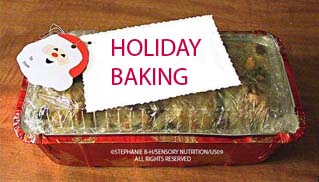
Want to lower the fat content of your holiday baked goods, but not quite sure how to accomplish that?
Read today’s blog for some helpful suggestions that may help you keep some flavor, but skip some fat.
Holiday Baking – Cookies and Their Ingredients Part 5 Fat Substitutes
Fat Substitutes:
When it comes to cookie making, most recipes are going to depend upon use of “full-fat” (80% fat), unsalted butter +/or unsalted margarine for the best success, since most cookie recipes were developed with those products as part of the proportional basis of the cookies.
Fat is something we desire, in part, because of how well it carries flavor, as well as how important healthier profile fatty acids are to our very survival. Although some fat substitutes may attempt to imitate the texture that fat also provides, unless they are other fats with a healthier nutrition profile being substituted for less desirable fats, they won’t be able to provide the same flavor that fat does.
Sometimes we don’t try to eliminate ALL of the fat in a baked good item, because either the texture, mouthfeel, or flavor perception simply will be too compromised if we attempt to do that.
The reality is that some baked goods recipe formulas simply cannot work if all the fat is removed and we may be limited in what options we have for home baking to find substitutes for some or all of the specific fat content that are satisfactory on a number of levels.
In other recipes, we may have more flexibility in what we can alter and still have acceptable tenderness, texture and flavor. For example, in University testing, Registered Dietitians found that pureed cannellini (white) beans could be substituted for shortening in brownies at levels of 25% and even up to 50%, while still yielding an acceptable lower fat product from a sensory perspective that was also more nutrient dense.
Sometimes we leave a little fat in the recipe or go with substituting some of a healthier nutrition profile fat so that in the end, the sensory perception of the baked good or other item is still desirable.
Although scientists are working hard to finds ways to “trick” the body into believing it is consuming fat when it isn’t, they aren’t quite fully there yet.
They have found, however, that polyunsaturated fats can activate taste receptors of the tongue, which is a new concept to many who have traditionally believed that the only “tastes” the human tongue can perceive are sweet, salty, sour, bitter, and umami.
Although our bodies may need some essential fatty acids that we have to obtain from food sources, most of us consume a lot more total fat and often it is of the less desirable fat profiles from a nutritional standpoint. Concerns for consuming excess calories, or fats with less desirable nutrition profiles which are associated with chronic disease incidence and more, have gotten many individuals to thinking about skipping some of the fat in baking if possible.
Sometimes it is possible to “tweak” some cookie recipes to reduce the fat content per se, and it is possible to “tweak” some muffin, quick bread, sweet bread, and some cake recipes even more towards that end.
We’ve reviewed many different resources with ideas for fat substitutions, including those that could be used in baking. We’ll list some of those substitution resources, and then we hope we’ve garnered the best of them and included tidbits from our own experience to put into a written piece of our own.
We’re working on a handy chart to help you out with this at a glance, in case you’re interested. When ready it will be linked under the Resources Tab on this blog site via eBooklets–give us a few more days to have that ready for you.
Meanwhile, check out some readily available resources on the www to get your started on reducing fat in your holiday baking. Check back later this week for availability of our expanded, detailed chart.
Please keep something in mind about potentially shorter baking times and in some cases even lower baking temperatures when it comes to recipes that have been altered to reduce their fat content.
Reduced fat items may need to cook at a lower temperature and for a shorter period of time, because the batter or dough may be drier, so be aware of that and pay close attention when any recipe subsitutions are noted in a recipe because possibly an altered method, cooking temperature or cooking time might also be suggested.
You don’t want to over bake lower fat batters and doughs!
Selected Resources:
- Altering Recipes for Good Health AgriLife Extension Texas A&M System
- Fat Substitution and Low-Fat Cooking Utah State University Extension August 2008
- Ingredient Substitutions and Equivalents Utah State University Cooperative Extension FN255
- MICHELE SZAFRANSKI, MS, RD; JULIANNE ALLEN WHITTINGTON, MS, RD; CARLTON BESSINGER, PhD, RD Pureed Cannellini Beans Can Be Substituted for Shortening in Brownies. J Am Diet Assoc. 2005;105:1295-1298.
- Putting Fat on the Taste Map Tim Gilbertson featured Utah Science vol 62 Jan 2003
- Vegetable of the Month: Beans Centers For Disease Control


Comments are closed.